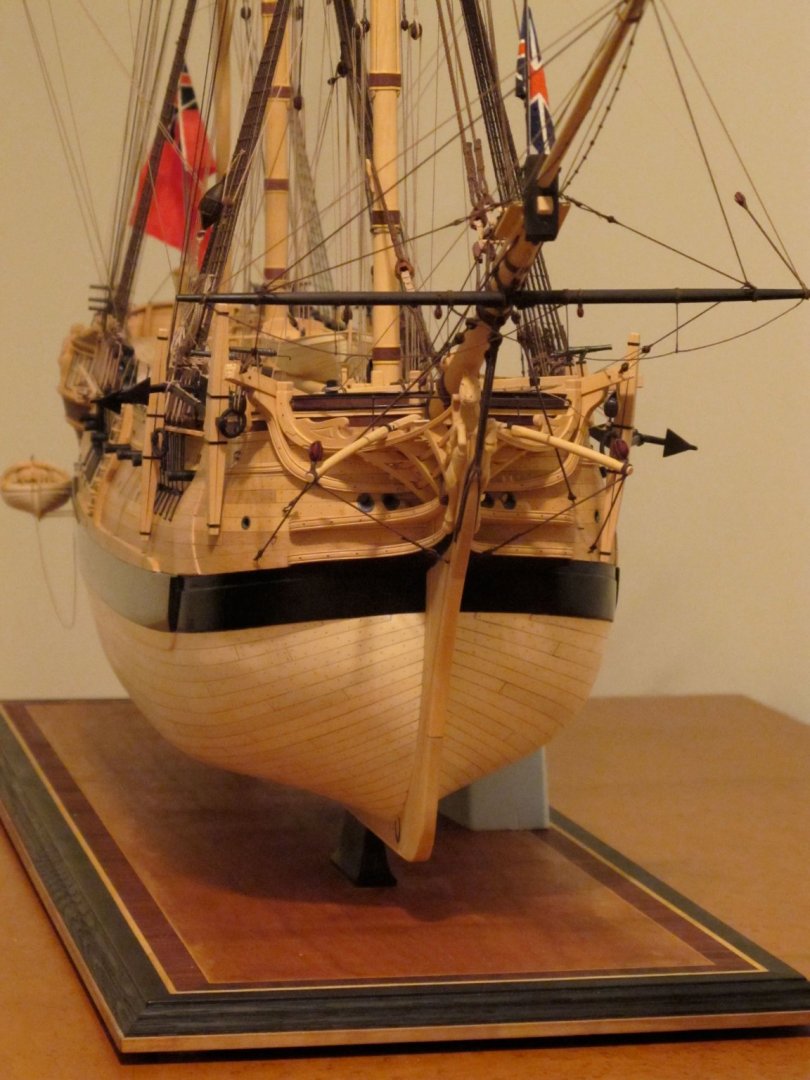-
Posts
13,361 -
Joined
-
Last visited
Content Type
Profiles
Forums
Gallery
Events
Everything posted by druxey
-
Welcome! What you wrote about your experience so far is exactly what all of us have gone through/are going through. You will have plenty of sympathy and advice if you need it here. For a first attempt, you've done very well. Your model looks like most folks' third or fourth!
-
I hope your grandson is watching and learning your techniques. Make sure he starts a log on MSW as well! We'll be watching.I 'm happy to read that he will carry the torch on for you.
- 29 replies
-
- hmw
- Hamburg Harbor
-
(and 2 more)
Tagged with:
-
I missed 'Nike' completely! Thanks for pointing it out. Early promotion, not for a shoe in this case, but a runner!
-
Looks like an early version of what was called a 'shoe block' in the 18th century. In that case, the two sheaves were set at right angles to each other. Think two single blocks joined end to end at right angles.
-
You might be interested to know I found a copy some years ago of The Practical Shipbuilder of 1839. It was reprinted in limited facsimile edition in 1940 by Richard McKay. Inside the front cover is glued a sliver of wood about 1" square and about 1/16" thick, labelled in pen: Piece of the Ways Donald McKay's Shipyard East Boston - 1845 - 1875 The book is dedicated and signed by Richard McKay. There are seven fold-out plates of representatire hull forms of a sloop, brig, etc, up to a large ship.
-
Terrific work, as usual, Danny. I'm sorry that you are having difficulty continuing. If you can't complete this model, I hope you know someone who can and do both the model and you justice.
- 29 replies
-
- hmw
- Hamburg Harbor
-
(and 2 more)
Tagged with:
-
You make this look very plausible, Sceatha!
- 81 replies
-
- egyptian
- byblos ship
-
(and 1 more)
Tagged with:
-

A question about glue.
druxey replied to danbloch's topic in Building, Framing, Planking and plating a ships hull and deck
Like the other gentlemen say! -
When I first made open boats, my molds were made with grooves for the frames. I realised later that I didn't need to do that: I simply built the planks, edge glued over a plain mold. After freeing the shell, I bent in the frames (this is at 1:48 scale). Works just fine and saves a lot of work. Clinker boats can be built in the same way. The only critical points are: a) The planks must be accurately spiled b) the fit between strakes be really tight in the case of the carvel hull
-
Not only do I enjoy looking in on your log and progress, but this little piece of etymology is fun to learn about as well!
- 81 replies
-
- egyptian
- byblos ship
-
(and 1 more)
Tagged with:
-
Don't drop the thread, Steven! That will cause the same issue of skinny planks, but just move it down. Two drop planks under the wale illustrated in the photo.
- 740 replies
-
- Tudor
- restoration
-
(and 4 more)
Tagged with:
-
Aft looks pretty nice to my eye. Forward is good, other than you may need to 'drop' a strake or two under the wale to avoid plank ends of the upper belt becoming too skinny into the bow rabbet.
- 740 replies
-
- Tudor
- restoration
-
(and 4 more)
Tagged with:
About us
Modelshipworld - Advancing Ship Modeling through Research
SSL Secured
Your security is important for us so this Website is SSL-Secured
NRG Mailing Address
Nautical Research Guild
237 South Lincoln Street
Westmont IL, 60559-1917
Model Ship World ® and the MSW logo are Registered Trademarks, and belong to the Nautical Research Guild (United States Patent and Trademark Office: No. 6,929,264 & No. 6,929,274, registered Dec. 20, 2022)
Helpful Links
About the NRG
If you enjoy building ship models that are historically accurate as well as beautiful, then The Nautical Research Guild (NRG) is just right for you.
The Guild is a non-profit educational organization whose mission is to “Advance Ship Modeling Through Research”. We provide support to our members in their efforts to raise the quality of their model ships.
The Nautical Research Guild has published our world-renowned quarterly magazine, The Nautical Research Journal, since 1955. The pages of the Journal are full of articles by accomplished ship modelers who show you how they create those exquisite details on their models, and by maritime historians who show you the correct details to build. The Journal is available in both print and digital editions. Go to the NRG web site (www.thenrg.org) to download a complimentary digital copy of the Journal. The NRG also publishes plan sets, books and compilations of back issues of the Journal and the former Ships in Scale and Model Ship Builder magazines.




